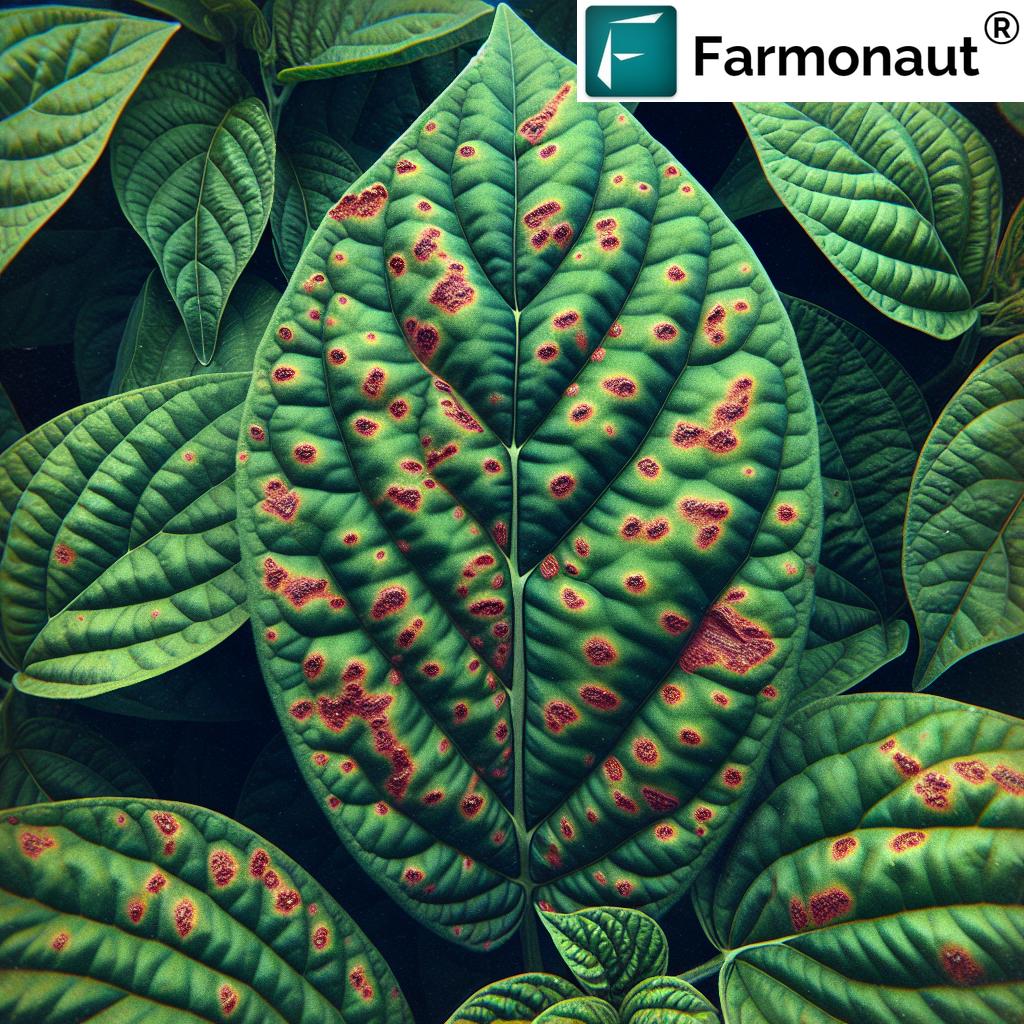
Understanding and Combating Rust in Plants: A Comprehensive Guide
At Farmonaut, we’re committed to helping farmers tackle the most pressing challenges in agriculture. One such challenge that many farmers face is the persistent threat of rust fungi. In this comprehensive guide, we’ll dive deep into the world of rust diseases, exploring their causes, symptoms, and most importantly, effective control methods for both organic and conventional farming practices.
What is Rust?
Rust is a common and destructive fungal disease that affects a wide range of plants, including important crops like beans, wheat, and corn. It’s caused by fungi belonging to the order Pucciniales, which includes thousands of species that can infect various plant hosts.
These fungi are obligate parasites, meaning they can only survive on living plant tissue. They derive their nutrients from the host plant, causing damage and reducing crop yields in the process.
The Impact of Rust on Agriculture
Rust diseases can have devastating effects on crop production worldwide. They can lead to:
- Significant yield losses
- Reduced crop quality
- Increased production costs due to the need for fungicide applications
- Long-term economic impacts on farming communities
Understanding rust and implementing effective control measures is crucial for sustainable agriculture and food security.
Common Types of Rust in Crops
While there are many species of rust fungi, some of the most economically important ones include:
- Bean Rust (Uromyces appendiculatus): Affects various bean species
- Wheat Stem Rust (Puccinia graminis f. sp. tritici): A major threat to wheat production
- Corn Rust (Puccinia sorghi): Impacts corn and sweet corn crops
- Soybean Rust (Phakopsora pachyrhizi): A significant concern for soybean farmers
Recognizing Rust Symptoms
Early detection is key to managing rust infections effectively. Here are the common symptoms to look out for:
- Leaf discoloration: Rust-colored, yellow, or brown spots on leaves
- Pustules: Small, raised bumps on leaf surfaces that release powdery spores
- Leaf drying and curling: Severe infections can cause leaves to dry out and curl
- Stem lesions: In some cases, rust can also affect plant stems

The image above shows typical rust symptoms on bean leaves. Note the characteristic rust-colored pustules.
The Rust Life Cycle
Understanding the life cycle of rust fungi is crucial for developing effective control strategies. The typical rust life cycle involves:
- Spore germination: Spores land on a suitable host plant and germinate under favorable conditions
- Infection: The fungus penetrates plant tissue and begins to grow
- Pustule formation: As the fungus matures, it forms pustules on the plant surface
- Spore production: Pustules release spores that can infect other plants
- Dispersal: Spores are spread by wind, rain, or insects to new host plants
Some rust species have complex life cycles involving alternate hosts, which can make control more challenging.
Factors Influencing Rust Development
Several environmental and agricultural factors can influence the development and spread of rust diseases:
- Temperature: Most rust fungi thrive in moderate temperatures (60-80°F)
- Humidity: High humidity or prolonged leaf wetness promotes infection
- Host susceptibility: Some plant varieties are more susceptible to rust than others
- Monoculture: Growing large areas of a single crop can facilitate rapid disease spread
- Plant density: Overcrowded plants can create favorable microclimates for rust development
Conventional Rust Control Methods
Conventional farming practices often rely on chemical fungicides to control rust infections. While effective, these methods can have environmental drawbacks and may lead to fungicide resistance over time. Common conventional control methods include:
- Preventive fungicide applications: Regular spraying to protect crops before infection occurs
- Curative fungicide treatments: Applying fungicides at the first sign of infection
- Resistant crop varieties: Planting rust-resistant cultivars when available
- Crop rotation: Alternating susceptible crops with non-host plants to break the disease cycle
Organic Rust Control Strategies
For organic farmers or those looking to reduce their reliance on synthetic chemicals, there are several effective organic control methods:
- Cultural practices:
- Proper plant spacing to improve air circulation
- Avoiding overhead irrigation to reduce leaf wetness
- Removing infected plant material to reduce inoculum
- Organic fungicides:
- Copper-based products (use with caution as they can accumulate in soil)
- Sulfur sprays (effective against many rust species)
- Neem oil (has antifungal properties and can deter some pests)
- Biological control:
- Beneficial microorganisms that can compete with or parasitize rust fungi
- Plant extracts with antifungal properties
- Resistant varieties:
- Choosing naturally rust-resistant cultivars
- Practicing crop diversity to reduce disease pressure
Innovative Rust Detection and Management with Farmonaut
At Farmonaut, we’re leveraging cutting-edge technology to revolutionize rust detection and management. Our satellite-based crop monitoring system offers several advantages over traditional scouting methods:
| Feature | Traditional Rust Detection | Farmonaut Satellite System Detection |
|---|---|---|
| Detection Speed | Slow (requires manual field scouting) | Fast (near real-time satellite imagery analysis) |
| Accuracy | Variable (depends on scout’s expertise) | High (uses advanced spectral analysis) |
| Coverage Area | Limited (time-consuming to cover large areas) | Extensive (can monitor entire fields at once) |
| Cost-effectiveness | Low (labor-intensive) | High (automated and scalable) |
Our system can detect early signs of rust infection by analyzing changes in plant spectral signatures. This allows farmers to take prompt action, potentially reducing the need for extensive fungicide applications.
Integrated Rust Management: Combining Traditional and Modern Approaches
The most effective rust management strategies often combine traditional knowledge with modern technology. Here’s how we recommend integrating various approaches:
- Early detection: Use Farmonaut’s satellite monitoring to identify potential rust hotspots in your fields
- Targeted scouting: Based on satellite data, conduct focused field inspections to confirm rust presence
- Precision treatment: Apply organic or conventional treatments only where needed, reducing overall pesticide use
- Cultural practices: Implement rust-prevention techniques like proper plant spacing and irrigation management
- Ongoing monitoring: Continuously track crop health using our platform to assess treatment efficacy and detect new outbreaks
Case Study: Bean Rust Management in Organic Systems
Bean rust (Uromyces appendiculatus) is a common challenge for organic bean farmers. Here’s an example of how an integrated approach can be effective:
- Variety selection: Choose bean varieties with known rust resistance
- Cultural practices:
- Plant beans in well-drained soil with good air circulation
- Use drip irrigation or water early in the day to minimize leaf wetness
- Monitoring: Utilize Farmonaut’s satellite monitoring to detect early signs of infection
- Organic treatments: At the first sign of rust:
- Apply a neem oil spray (mix 2-3 tablespoons per gallon of water)
- Follow up with copper-based fungicides if necessary, following organic certification guidelines
- Post-harvest practices: Remove and destroy infected plant material to reduce overwintering inoculum
The Future of Rust Management
As climate change alters disease patterns and new rust races emerge, innovative approaches to rust management will become increasingly important. At Farmonaut, we’re continually developing new tools to help farmers stay ahead of these challenges:
- AI-powered disease forecasting: Predicting rust outbreaks based on weather patterns and historical data
- Hyperspectral imaging: Enhancing our ability to detect rust infections at even earlier stages
- Integration with precision agriculture systems: Allowing for automated, targeted fungicide applications
- Collaborative research: Partnering with agricultural institutions to develop new rust-resistant crop varieties
Conclusion
Rust diseases pose a significant threat to global crop production, but with a combination of traditional knowledge, organic practices, and cutting-edge technology, we can effectively manage these challenges. By leveraging Farmonaut’s advanced satellite monitoring system alongside integrated pest management strategies, farmers can protect their crops while minimizing environmental impact and production costs.
We encourage all farmers to explore how our platform can enhance their rust management efforts. Visit our website to learn more about our services or download our mobile app (Android | iOS) to start monitoring your fields today.
FAQs
Q: Can rust infections spread to humans or animals?
A: No, rust fungi are specific to plants and do not infect humans or animals. However, severe rust infections can reduce crop yields, potentially impacting food security.
Q: How quickly can rust spread in a field?
A: Under favorable conditions, rust can spread rapidly. A single rust pustule can produce thousands of spores, and with wind dispersal, an entire field can become infected within days to weeks.
Q: Are there any natural predators of rust fungi?
A: While rust fungi don’t have direct predators, some hyperparasitic fungi can infect rust pustules. However, these are not typically used for commercial biological control.
Q: How often should I monitor my fields for rust?
A: With traditional methods, weekly scouting is recommended during susceptible growth stages. Using Farmonaut’s satellite monitoring, you can receive updates every few days, allowing for more frequent and comprehensive monitoring.
Q: Can crop rotation eliminate rust problems?
A: Crop rotation can help reduce rust inoculum, but it may not eliminate the problem entirely, especially for rust species with alternate hosts or long-distance spore dispersal.
Q: Are organic fungicides as effective as conventional ones?
A: Organic fungicides can be effective when used as part of an integrated management strategy. While they may not always match the immediate efficacy of synthetic fungicides, they can provide adequate control with fewer environmental concerns.
Q: How can I access Farmonaut’s satellite monitoring for my farm?
A: You can sign up for our services through our website or mobile app. We offer various subscription plans to suit different farm sizes and needs.
For developers interested in integrating our rust detection capabilities into their own applications, we offer a comprehensive API. Check out our API documentation or visit our API portal to get started.
By combining traditional agricultural wisdom with modern technology, we can work together to combat rust diseases and ensure sustainable crop production for future generations.

